|
40 |
Vinnie Jones (1989-1990) |
 |
|
Jones arrived from Wimbledon in June 1989 for
£600,000 and became a Leeds cult figure overnight.
Notoriety seemed to follow the former hod-carrier
from the day he turned professional in 1986. The
Ball-winning midfielder had been sent off three
times in his Wimbledon career. Dubbed 'Psycho' by
the media, he cleaned up his act and his long throw
ins were a regular source of goals as he added a
Second Division Championship medal to his already
won FA Cup medal. The arrival of Gary McAllister saw
him lose his first team spot and after 15 happy
months, which saw him play 51 full games and score 9
goals, he left for Sheffield United for £700,000 in
1990, later returning to Wimbledon via Chelsea.
Always controversial he was sent off in his fourth
of 9 Welsh International Appearances and a total of
12 times in his career.
Visit "Leeds United F.C. History" for more detailed information |
|
|
|
39 |
Olivier Dacourt (2000-2003) |
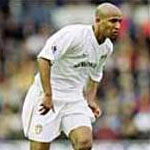 |
|
French International Dacourt first made his mark at
RC Strasbourg, breaking through in the 1993/94
season. Everton paid £4m for his services. Scored
twice in 30 games in his only season at Goodison
Park before being transferred back to France,
joining RC Lens for £6.5m. His all-action
displays helped Lens reach the semi-finals of the
UEFA Cup. Returned to England to sign for Leeds
in an £7.2m deal and immediately added steel and
quality to their youthful midfield. He starred
as United reached the semi-finals of the UEFA
Champions League. His star dipped from then on,
though, and Dacourt joined AS Roma on loan in
January 2003 before making the deal permanent in the
summer. He played 78 games and scored 3 goals.
Visit "Leeds United F.C. History" for more detailed information |
|
|
|
38 |
Alan Smith (1998-2004) |
 |
|
Scored with his first
touch in senior football as Leeds beat Liverpool in
November 1998, going on to to establish himself as
Jimmy Floyd Hasselbaink's first choice striking
partner for the rest of that season. Smith coupled a
deadly eye for goal with a real aggression, unusual
in one so slight of stature. Smith gained excellent
experience during Leeds' successful Champions League
run during the 2000/01 season, the return of 11
Premiership goals was the best of his career. He
made his England debut in 2001. His disciplinary
record continued to haunt him the next season, as he
picked up a total of three red cards and 12 yellow
in all competitions. And a return of just three
Premiership goals was far from impressive. The
2003/04 season was a huge one for Smith, he remained
a shining light in a dismal Leeds team and was an
inspiration. Smith scored 56 goals in a total of 228
games before leaving for Man U.
Visit "Leeds United F.C. History" for more detailed information |
|
|
|
37 |
Gordon McQueen (1972-1978) |
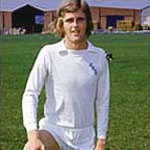 |
|
Born 1952 and capped 30 times by Scotland the
towering centre-half played initially for St Mirren
in 1970 before joining LUFC as Jack Charlton's
replacement in 1972 for £30,000 , where he became
first choice in the championship winning 1974-75
team. Full Scottish honours followed quickly before a
British Record £495,000 took him to Man U in 1978,
where he won an FA Cup winners medal. His aerial
power made him a formidable opponent, but his career
was blighted by injury, firstly a bad Achilles
tendon injury at Leeds and later a spate of injuries
at Manchester. He made 171 starts and scored 18
goals.
Visit "Leeds United F.C. History" for more detailed information |
|
|
|
36 |
Joe Jordan (1970-1978) |
 |
|
"Dracula" was bought from Greenock to Leeds in 1970
for a bargain £15,000 . A powerful striker, he
scared opposition defenders and keepers with his
toothless snarl, resulting in 48 goals in the eight
years he was at our club. Always fighting for his
place in the team, with Jones or Clarke, he
nevertheless made 220 starts for Leeds before moving
to Manchester Utd in 1978. Capped 52 times for
Scotland, he scored the goal that took them to the
1974 World Cup.
Visit "Leeds United F.C. History" for more detailed information |
|
|
|
35 |
Mel Sterland (1989-1993) |
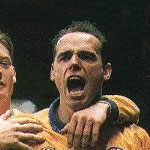 |
|
Born Sheffield 1961, he joined his home club
Wednesday and turned professional in 1979. He played
a key role in their 1984 promotion to the top
flight. He gained 7 under 21 and a "B" cap before
his sole England cap in 1988. He was sold for a club
record £800,000 to Glasgow Rangers in 1989 where he
won a League Championship medal before rejoining his
former Manager Howard Wilkinson at Leeds for £600,000
the same year. Dubbed "Zico" by the fans because of
his ability to score spectacular goals, his dynamic
runs down the right and booming crosses brought many
goals for Lee Chapman as Leeds swept firstly to the
Second Division title and later to First
Division Championship in the space of three years.
Injuries took their toll and he retired in 1994
after 143 starts and 20 goals.
Visit "Leeds United F.C. History" for more detailed information |
|
|
|
34 |
Dominic Matteo (2000-2004) |
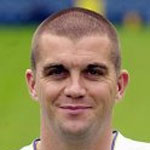 |
|
Born Dumfries in 1974. Capped at England Under-21 and
'B' levels.
He made his Scotland
debut in 2000. His versatility saw him fill numerous
roles for the both Leeds and Liverpool, including
midfield and central defensive spots, coaches
believed that his best position was at left-back. A
good range of passing and the skill and confidence
to take opponents on led Leeds signing him
for £4.25. He debuted against AC Milan in the
Champions League, then netted his first Leeds goal
against Besiktas. He was handed the captaincy for
the 2002/03 season and signed a new, extended
contract. However, he was not able to save Leeds
United from the drop in 2003/04, despite a number of
committed performances in both defence and midfield,
moving on to Blackburn Rovers at the end of the
season.
Visit "Leeds United F.C. History" for more detailed information |
|
|
|
33 |
Albert Johanneson (1961-1970) |
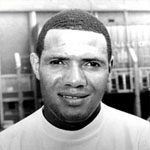 |
|
A member of Don Revie's great Leeds side, was seen
as something of a "novelty player", but still
mesmerised opposing teams with his dancing runs down
the wing. He was the first black player to appear in
an F.A. Cup Final, in 1965 against Liverpool, but in
most games he was the victim of deliberate and
dangerous fouling by desperate defenders. His
resulting injuries led to a lack of confidence and
the emergence of Eddie Gray meant he struggled to
fulfil his potential, before leaving Leeds in 1970
and moving on to York. After two years there he
retired into obscurity, suffering health and drink
problems and in 1995 died alone, aged 53, in a
Gledhow bedsit, in Leeds.
Visit "Leeds United F.C. History" for more detailed information |
|
|
|
32 |
Jonathan Woodgate (1997-2003) |
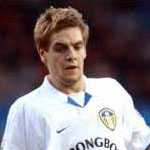 |
|
He
joined the club at the age of 13 and was part of the
side that won the FA Youth Cup in 1997, moving to
the first team regularly in 1998. His aerial
abilities, combative nature and calmness on the ball
led to him being earmarked as an England regular of
the future. Indeed his superb first season was
capped by a call up from Kevin Keegan to the full
England squad at the tender age of 19. He had a
wonderful 1999/2000 season until events off the
pitch saw his form understandably dip. He agreed a
new contract with Leeds in the summer of 2002 that
would keep him at Elland Road for five years.
Woodgate served nearly three years of suspension
from international duty due to his court case.
Woodgate moved to Newcastle in January 2003 and
only 20 months later secured a move to Real Madrid.
Visit "Leeds United F.C. History" for more detailed information |
|
|
|
31 |
David Harvey (1965-1979, 1983-1985) |
 |
|
Born Leeds in 1948, he joined United in 1965 and such
was the brilliance of Gary Sprake that he had to
make about 200 Central league appearances before
establishing himself as a first team regular and
gaining a FA Cup winners medal in 1972. His career
took off and he was capped 16 times for Scotland,
his father was Scottish, and he was rated the best
goalkeeper in the 1974 World Cup. A bad car accident
in early 1975 saw him temporarily lose his place to
David Stewart, who took his place in the Scottish
team and in the European Cup Final. He regain his
place, but he joined Vancouver Whitecaps in 1980.
He returned to Leeds in 1983 before finally leaving
in 1985. His 445 appearances is all the more
remarkable when considering his many games for the
Reserves.
Visit "Leeds United F.C. History" for more detailed information |
|
|
|
30 |
Rio Ferdinand (2000-2002) |
 |
|
A supremely elegant
footballer who defends with intelligence and guile,
but also uses the ball when possession is
gained. Leeds smashed not only the British transfer
record, but also the world record fee for a defender
to prise him away from Upton Park. Paying £18m for
Ferdinand, a fee which sent shockwaves through the
footballing world. The move undoubtedly benefited
Rio, who improved his ability and claimed a spot in
the England set-up as the old rearguard was phased
out. At the 2002 World Cup he emerged as a truly
world class defender. He was a rock as England went
out to Brazil in the quarter-finals. He left for Man
U for £29.3million. Player of the Year at Leeds in
his final season, Ferdinand was a real favourite at
Leeds, played 73 games for the club and scored three
goals.
Visit "Leeds United F.C. History" for more detailed information |
|
|
|
29 |
Trevor Cherry (1972-1982) |
 |
|
Born Huddersfield, 1948, he signed for his home town
team in 1965 and captained them to the Second
Division Championship in 1969-70. He moved to Leeds
for £100,000 in 1972, and, while formerly almost
exclusively a central defender, his ability to play
midfield and full back made him a valuable
acquisition. He won 27 caps for England and had the
honour of captaining his country, but he was also
one of the few England players to be sent off. He
won a League championship medal in 1974 and played
477 full games and 8 as substitute, scoring 32 goals
before joining Bradford City as player manager and
led them to promotion to Division 2.
Visit "Leeds United F.C. History" for more detailed information |
|
|
|
28 |
Gary Speed (1988-1996) |
 |
|
Born 1969, Speed joined Leeds straight from school
in 1987. A Welsh Youth International, he got his
first team chance after he scored in 12 consecutive
Northern Intermediate League games. After one
appearance for the first team he was called into the
Welsh full squad for whom he appeared 34 times
whilst at Leeds. He excelled in Uniteds'
championship winning team when his forays down the
left and his ability in the air brought him , and
others, plenty of goals. He made 291 full and 20
substitute appearances scoring 57 goals before
moving to Everton for £3.4m in 1996. He later moved
to Newcastle United and a testament to his longevity and
freedom from serious injury was that Gary held the record
for most appearances of any outfield player in the EPL,
long after his retirement.
Visit "Leeds United F.C. History" for more detailed information |
|
|
|
27 |
Jimmy-Floyd Hasselbaink (1997-1999) |
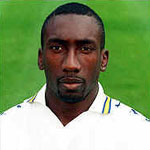 |
|
Surinam born, moved with his family to Holland and
started his European football with Telstar, then AZ.
Coming to Leeds from Boavista, for £2M in 1997, he
soon became a firm favourite with the fans...if not
with the management. Produced 42 (usually
flamboyant) goals in 87 Leeds appearances, but was
too temperamental for George Graham's liking and was
frequently substituted. O'Leary gave him his
chances, but in the summer of 1999 he was
transferred to Athletico Madrid, for £12M. under
very unclear circumstances. The official Leeds board
statement said he demanded a new wage contract far
above what they were prepared to pay. Jimmy himself
says he wanted to stay at Leeds, as he saw O'Leary's
team gearing up for European success, and that he
was sold off to provide the money needed to take
Leeds into Europe.
Visit "Leeds United F.C. History" for more detailed information |
|
|
|
26 |
John Sheridan (1982-1989) |
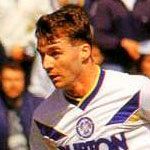 |
|
Discarded by Manchester City, Sheridan went on to
become a major influence in the Leeds midfield as
they strove to recapture Division One status in the
1980s. Within six months of being rejected by Man
City, he had made his league debut for Leeds, his
vision and skill hallmarking him as a player for the
future. He recovered well from a broken leg
sustained at Barnsley in 1983, to become United's
most valuable playing asset, being particularly
lethal from free kicks. On the arrival of Howard
Wilkinson as manager Sheridan was sold to Nottingham
Forest.
Visit "Leeds United F.C. History" for more detailed information |
|
|
|
25 |
Lee Bowyer (1996-2003) |
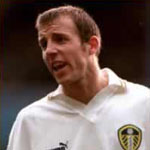 |
|
Bowyer moved to Leeds United in July 1996 from
Charlton Athletic for a then British record fee for
a teenager of £3 million.
After taking a long
time to settle, his performances led to him being
voted United's Player of the Year for 1998/99. A
hard-working player, hard in the tackle and with an
eye for goal, Bowyer looked to be the fringe of an
England place until his well-publicised troubles.
Bowyer showed magnificent form in the first half of
the 1999/2000 season, he was a star at home and in
Europe as Leeds made the semi-finals of the
Champions League, and he almost finished top scorer
in the competition. He was one of the best players
in the Premiership throughout 2000/01, even though
his court case was in progress. He left Leeds in
2003 for West Ham before moving to Newcastle United.
Visit "Leeds United F.C. History" for more detailed information |
|
|
|
24 |
Lee Chapman (1990-1993, 1996) |
 |
|
Born Lincoln in 1959, he began his professional career
with Stoke City in 1978, where he once recorded a
hat-trick against Leeds, showing early promise in
winning an England under 23 cap. After establishing
himself at Stoke, his career faltered and he played
with Arsenal, and Sunderland before Howard Wilkinson
took him to Sheffield Wednesday in 1984. He
netted 69 goals in 149 games for the Owls before
taking on an unsuccessful sample of French football,
which quickly saw him return to England with
Nottingham Forest, where he won League Cup and Zenith
Cup winner's medals. He joined Leeds in 1990 and led
them to the Second Division and First Division
Championships in quick succession. He played 171
games and scored 80 goals. He left in 1993
but returned for a short loan spell in 1996.
Visit "Leeds United F.C. History" for more detailed information |
|
|
|
23 |
Tony Currie (1976-1979) |
 |
|
Born in Edgeware, London in 1950. Tony Currie was
the nearest thing Leeds has to fill the Bremner,
Giles combination. His delicate skills and passing
ability saw him win 11 of his 17 caps for England
while a Leeds player. He was sold by Sheffield
United to Leeds in 1976 and Currie maintained his
star status at Elland Road, adding consistently to
his talents. For two season he was a regular in the
England squad but could not add domestic honours. He
played 123 games for Leeds and scored 25 goals.
Visit "Leeds United F.C. History" for more detailed information |
|
|
|
22 |
Tony Yeboah (1995-1997) |
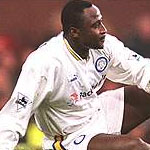 |
Born Ghana 1966, few strikers have made such an
explosive impact as Yeboah. Outside the
Bundesliga few had heard of the Ghanaian's goal
power, but it did not take long for him to take
English Football by storm with a series of
spectacular goals. Leeds shattered the club's
transfer record in paying Eintracht Frankfurt
£3.4m in early 1995. He soon picked up the pace
with 13 goals in his first 16 games. His goals
ensured a UEFA Cup place and he did not
disappoint in Europe when a virtuoso performance
netted him an hat-trick at Monaco,. This was
followed quickly by another hat-trick at
Wimbledon. It included a blistering shot shot
which was only surpasses by a match winning
volley against Liverpool, which earned him the
goal of the year award. He sustained a
succession of injuries while on International
duty and left the club in 1997. Winner of the
Leeds player of the year award in 1996 he made
55 full and 4 substitute appearances and netted
32 goals.
Visit "Leeds United F.C. History" for more detailed information |
|
|
|
21 |
Bobby Collins (1962-1967) |
 |
|
Small in stature, but huge in standing amongst
United's galaxy of greats, Collins was the platform
on which manager Don Revie launched his great sides.
Revie paid £25,000 to Everton in March 1962 for the
31 year old former Scottish international, who went
on to lift a mediocre club out of the depths of
Division Two to one of the most successful in
Europe. He captained Leeds to the Second Division
title in 1963-64 and the following season was voted
footballer of the year as Leeds came close to a
League and Cup double. He was capped 31 times for
Scottland.
Visit "Leeds United F.C. History" for more detailed information |

